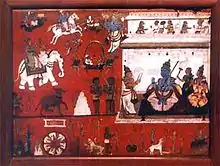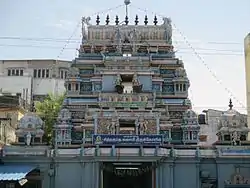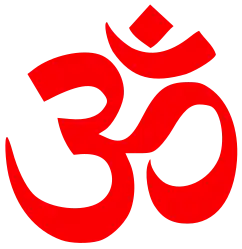Chitragupta
Chitragupta (Sanskrit: चित्रगुप्त, 'rich in secrets' or 'hidden picture') is a Hindu god assigned with the task of keeping complete records of the actions of human beings and punishing or rewarding them according to their karma. Upon their death, Chitragupta has the task of deciding heaven or hell for humans, depending on their actions on the earth. Chitragupta is the seventeenth Manasputra of Lord Brahma. Chitragupta is believed to have been created from Brahma's soul and mind (chit) and thus, allotted the right to write Vedas like Brahmins with the duty of a Kshatriya. Chitragupta accompanies Yama, the god of death.[1]
| Lord Chitragupta | |
|---|---|
.jpg.webp) Lord Chitragupta in Bangkok City Pillar Shrine Thailand. | |
| Devanagari | चित्रगुप्त |
| Sanskrit transliteration | Citragupta |
| Affiliation | Deva, Dharmaraja |
| Mantra | ॐ श्री चित्रगुप्ताय नमः
(Oṃ shri chitraguptaaya Namaḥ) |
| Weapon | lekhani (Pen), Katani (Ink) and Katar (dagger) |
| Personal information | |
| Parents | Brahma (father) |
| Siblings | Four Kumaras, Narada, Daksha |
| Consort | Nandini and Shobhavati |
| Children | 12 sons: Bhanu Vibhanu Vishavbhanu Viryavan Charu Chitracharu Matiman Sucharu Charusta Himvan Chitraksha Atindaya |
| Part of a series on |
| Hinduism |
|---|
 |
|
In scriptures
- According to the Vedic scriptures, the souls of men after death receive rewards and punishments according to their sins and virtues, and hence it is believed that good and bad deeds of men are not destroyed. The souls of men after death go to Yamaloka, which is presided over by the deities called Yamadutas who keep records of men's actions and accordingly give them their dues. The principal deity of Yamaloka is Yamaraj — the ruler of Yamaloka, and the king of laws.
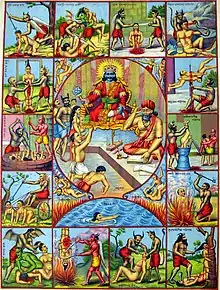
- The Yama Samhita, an extract from the 9th chapter of Ahilya Kamdhenu, a work of Hindu Law, says that Dharamaraja complained to Brahma about his difficulties in performing his most responsible duties of keeping records of the deeds of men and doing justice to them. Brahma went into meditation. Chitragupta sprang from his body and stood before him bearing an inkpot and a pen. The god Brahma (creator) said: "Because you are sprung from my body (kaya), therefore you shall be called Kayastha and as you existed in my body unseen I give you the name of Chitragupta. Let the Kshatriya dharma be followed by you and your progeny." He then assumed charge of Yamapuri. Yama setup marriage of his daughter Irawati with Chitragupta. Sraddhadeva Manu, son of Lord Surya, setup his daughter Nandini's marriage with Chitragupta. Chitragupta had eight sons from the former and four from the latter and these twelve sons became the progenitors of the twelve subdivisions of the Chitraguptavansi Kayasthas, namely Saxena, Mathur, Gaur, Nigam, Ashthana, Kulshrestha, Suryadwaja, Bhatnagar, Ambastha, Shrivastava, Karna and Vaalmik.
- According to Padma Purana, "Chitragupta was placed near Yama to register the good and evil actions of all sentient beings, that he was possessed of supernatural wisdom and became the partaker of sacrifices offered to the gods and fire. It is for this reason that the twice-born always give him oblations from their food. As he sprang from the body of Lord Brahma he was called Kayastha of numerous gotras on the face of the earth."
- Bhavishya Purana states that God, the Creator, gave the name and duties of Chitragupta as follows: Because you have sprung from my body, therefore, you shall be called Kayastha and shall be famous in the world by the name of Chitragupta. Oh my son, let your residence be always in the region of the God of justice for the purpose of determining the merits and demerits of men.
- Vignana Tantra says the same thing.
- The same is the enjoinment of Brahma to Chitragupta according to Brihat Brahma Khanda. He was named Kayastha having sprung from the body (kaya) of Brahma. He was directed to perform all sanskars and to have writing as his profession.
- Garuda Purana describes the imperial throne of Chitragupta in Yamaloka holding his Court and dispensing justice according to the deeds of men and maintaining their record, in the following words: (There Dharmaraja, Chitragupta, Sravana and others see all sins and virtues remaining concealed in the bodies of men).
- The Mahabharata (Anusasan Parva, chapter 130) recites the teaching of Chitragupta requiring men to do virtuous and charitable acts and performing Yagya, saying that men are rewarded or punished according to their good or bad deeds.
Family
The immediate family of Chitraguptaji consists of two wives and 12 sons.[2] He had four sons with his elder wife, Shobhavati, who was daughter of a Brahmin Susharma. He also had 8 sons with his second wife, Nandini, who was daughter of a Kshatriya Shradhadev Manu. The descendants of their 12 sons form the extended family divided into 12 lineages.[3]
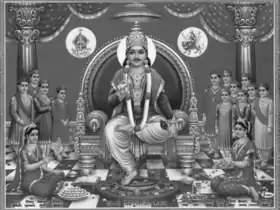
Legends
Chitragupta came into being after Brahma, the creator, having established the four varnas — Brahmin (The Learned), Kshatriya (The Warriors), Vaishya (Merchant & Farmers) and Shudra (Labourer) — ordained Yama to keep record of the deeds — good and evil — of all life-forms born and yet to be born on earth, in the heavens above and in the lands below. Yama, however, complained, "O Lord, how can I alone keep record of the deeds of the beings born into 84 lakh yonis (84,00,000 life-forms) in the three worlds"
Brahma went into meditation for 11,000 years and when he opened his eyes he saw a man holding pen and ink-pot in his hands and a sword girdled to his waist. Brahma spoke:
Thou hast been created from my body (Kaya), therefore shall thy progeny be known as the Kayasthas. Thou hast been conceived in my mind (Chitta or Chitra) and in secrecy (gupta), thy name shall also be Chitragupta. Let the role of a Kshatriya be followed by thee and thy progeny.
Brahma then enjoined him to dispense justice and punish those who violated the dharma.
In the Garuda Purana, Chitragupta is hailed as the "giver of letters" (Chitragupta namastubhyam vedaksaradatre).
In the legends of Chitragupta as well as in the Vedas, he is referred to as the greatest king, while the rest are "Rajakas," or little kings.
चित्र इद राजा राजका इदन्यके यके सरस्वतीमनु।
पर्जन्य इव ततनद धि वर्ष्ट्या सहस्रमयुता ददत॥ RIG VEDA Book 8/ Hymn 21/ Stanza 18
[4]
The Rig Veda mentions an invocation to be made to Chitragupta before offering sacrifice. There is also a special invocation to Chitragupta as Dharmraj (Lord of Justice) to be made at the performance of shradh or other rituals.
Om tat purushaya vidmahe Chitragupta dhimahi tena lekha prachodayata.
Chitragupta is said to have been born in humanform at Kayatha in Ujjain, which is also an important archeological site with evidence of cultures dating back to more than 4000 years, with a temple dedicated to him.[5] [6][7]
Chitragupta is the Athi Devathai for Ketu, one of the Navagrahas, and those who worship Chitragupta, would be bestowed with prosperity. Also the evil effects of Ketu during its transit period would be mitigated.
Worship and festivals
Chitragupta is worshipped daily by Kayastha community of North India, who are said to be his descendants in the Puranas, and worshipped on a mass scale on the occasion of Avtaran diwas on Chaitra Poornima and Kalam Dawat Puja on Yama Dwitiya.[8][9][10][11]
He is also worshipped in association with Yama, as on Yama Dwitiya in North India and in certain ancient isolated regions such Chitral district by the Chitral river in the Swat(Suvastu) region in the north-western Indian subcontinent.[12][13][14][15][16][17][18][19] The language spoken amongst others are Chitrali and Kalash. Of note is the fact that even in the remaining currently practiced form of ancient Hinduism in the region, certain deities were revered either in one community/tribe or other. Only one was universally revered as the Creator that is the ancient Hindu god Yama Râja called imr'o in Kâmviri. The ancient region had historical and cultural links to the nearby regions of Gilgit-Baltistan, Kashmir and Nooristan. The Srivastu/Suvastu region is also said to be the place of origin of Srivastava clan.[20]
Temples
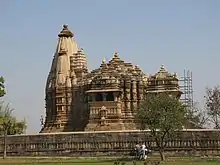
There are numerous temples dedicated to Chitragupta. Notable examples include:
- Chitragupta temple, Khajuraho, Madhya Pradesh
- Chitragupta temple, Kayatha, Ujjain, Madhya Pradesh - Chitragupta is said to have been born in humanform at Kayatha in Ujjain, which is also an important archeological site with evidence of cultures dating back to more than 4000 years, with a temple dedicated to him.[5][6][7]
- Chitragupta temple, Kanchipuram, Tamil Nadu - the oldest temple in South India dedicated to Chitragupta. Archaeologist have confirmed based on the inscriptions that the temple was built during the 9th century by the Medieval Cholas.[21][22]
- Chitragupta Devalayam, Falaknuma, Hyderabad - built by Kayasthas employed by the Qutb Shahi's in early 18th centuary.[23]
In popular culture
- Yam Hain Hum Hindi TV Series SAB TV
- Dharmakshetra Hindi TV series EPIC CHANNEL
References
- "Lord Chitragupta - Who helps Lord Yamaraj to maintain karmic accounts". 5 December 2017.
- Rajnī Kānt Śāstrī (1949). Hindū jati kā utthān aur patan. Kitab Mahal.
अब चित्रगुप्त के विवाह संबंध की वार्ता सुनिए। इनकी दो स्त्रियां थीं-(१)सुशर्मा ब्राह्मण की कन्या शुभावती (ब्राह्मणी) जिसके आठ पुत्र हुए श्रौर (२)श्राद्धदेव मनु की पुत्री नन्दिनी (चत्रिया) जिसके चार पुत्र हुए।
- Hayden J. Bellenoit (17 February 2017). The Formation of the Colonial State in India: Scribes, Paper and Taxes, 1760–1860. Taylor & Francis. ISBN 978-1-134-49429-3.
The north Indian Kayasthas are divided into 12 subgroups, reflecting King Chitragupta's marriage to Devi Nandini and Devi Shobhavati
- Bryant, Edwin; Patton, Laurie L. (2005). The Indo-Aryan Controversy: Evidence and Inference in Indian History. ISBN 9780700714636.
- MK Dhawalikar & ZD Ansari (1975). Excavations at Kayatha. Pune: Lokasangraha Press.
{{cite book}}: CS1 maint: uses authors parameter (link) - RK Sharma & OP Misra (2003). Archaeological Excavations in Central India: Madhya Pradesh and Chhattisgarh. New Delhi: Mittal Publication. ISBN 81-7099-874-3.
{{cite book}}: CS1 maint: uses authors parameter (link) - Sahay, Uday (2021). Kayasth Encyclopedia. Delhi: SAUV communications. ISBN 978-81-941122-3-5.
- Davidson, Ronald M (2005). Tibetan renaissance: Tantric Buddhism in the rebirth of Tibetan culture. New York: Columbia University Press. p. 179. ISBN 978-0-231-50889-6. OCLC 808346313.
- Stout, Lucy Carol (1976). The Hindustani Kayasthas: The Kayastha Pathshala, and the Kayastha Conference, 1873-1914. University of California, Berkeley. p. 14.
- R. B. Mandal (1981). Frontiers in Migration Analysis. Concept Publishing Company. p. 175. ISBN 978-03-91-02471-7.
- R. B. Mandal (1981). Frontiers in Migration Analysis. Concept Publishing Company. ISBN 978-03-91-02471-7.
- Guillard, J.M. (1974). Seul chez les Kalash. Carrefour des Lettres.
- Bezhan, Frud (19 April 2017). "Pakistan's Forgotten Pagans Get Their Due". Radio Free Europe/Radio Liberty. Retrieved 11 July 2017.
About half of the Kalash practice a form of ancient Hinduism infused with old pagan and animist beliefs.
- Barrington, Nicholas; Kendrick, Joseph T.; Schlagintweit, Reinhard (2006). A Passage to Nuristan: Exploring the Mysterious Afghan Hinterland. I.B. Tauris. p. 111. ISBN 978-1845111755.
Prominent sites include Hadda, near Jalalabad, but Buddhism never seems to have penetrated the remote valleys of Nuristan, where the people continued to practise an early form of polytheistic Hinduism.
- Weiss, Mitch; Maurer, Kevin (2012). No Way Out: A Story of Valor in the Mountains of Afghanistan. Berkley Caliber. p. 299. ISBN 978-0425253403.
Up until the late nineteenth century, many Nuristanis practised a primitive form of Hinduism. It was the last area in Afghanistan to convert to Islam—and the conversion was accomplished by the sword
- http://www.people.fas.harvard.edu/~witzel/KalashaReligion.pdf
- Jamil, Kashif (19 August 2019). "Uchal — a festival of shepherds and farmers of the Kalash tribe". Daily Times. p. English. Retrieved 23 January 2020.
Some of their deities who are worshiped in Kalash tribe are similar to the Hindu god and goddess like Mahadev in Hinduism is called Mahandeo in Kalash tribe. ... All the tribal also visit the Mahandeo for worship and pray. After that they reach to the gree (dancing place).
- West, Barbara A. (2010). Encyclopedia of the Peoples of Asia and Oceania. Infobase Publishing. p. 357. ISBN 978-1438119137.
The Kalasha are a unique people living in just three valleys near Chitral, Pakistan, the capital of North-West Frontier Province, which borders Afghanistan. Unlike their neighbors in the Hindu Kush Mountains on both the Afghani and Pakistani sides of the border the Kalasha have not converted to Islam. During the mid-20th century a few Kalasha villages in Pakistan were forcibly converted to this dominant religion, but the people fought the conversion and once official pressure was removed the vast majority continued to practice their own religion. Their religion is a form of Hinduism that recognizes many gods and spirits and has been related to the religion of the ancient Greeks... given their Indo-Aryan language, ... the religion of the Kalasha is much more closely aligned to the Hinduism of their Indian neighbors that to the religion of Alexander the Great and his armies.
- Ghai, Rajat (17 February 2014). "Save the Kalash!". Business Standard India.
- S. S. Shashi, ed. (1996). Encyclopaedia Indica: India, Pakistan, Bangladesh: Volume 100. Anmol. p. 117. ISBN 978-81-7041-859-7.
- "Shrine for Chitragupta". The Hindu. 18 April 2003. Archived from the original on 27 June 2003. Retrieved 2012-06-12.
- Harshananda, Swami (2012). Hindu Pilgrimage Centres (second ed.). Bangalore: Ramakrishna Math. p. 61. ISBN 978-81-7907-053-6.
- "Chitragupta Temple in Hyderabad | Uppuguda Hyderabad". wiki.meramaal.com. 2018-03-17. Retrieved 2022-04-12.
